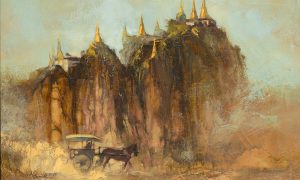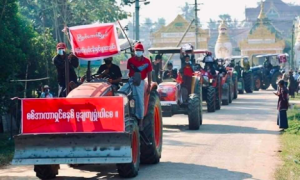It has often been said that intelligence is the world’s second oldest profession. Whether or not that is true, Myanmar cannot lay claim to being among its earliest practitioners. In Asia, that title probably lies with the rulers of the Indian subcontinent, or perhaps the Chinese. For example, the Rg Veda, believed to have been written around 1400 BCE, refers to spasa, or “watchers”, who keep mankind under surveillance on behalf of the god Varuna. Kautilya’s Arthashastra, probably composed in the 2nd Century BCE, recommends the creation of a secret service and encourages covert activities.[1] It describes two broad categories of agent, stationary spies and roaming spies. Both were to be employed against enemies, foreign and domestic, and used to ascertain the loyalty of the population.[2] The Chinese treatise known as The Art of War includes a chapter about espionage and the employment of spies. It states, among other things, that “the end aim of spying in all its five varieties is knowledge of the enemy”.[3] The book is traditionally ascribed to the strategist and philosopher Sun Tzu (birth name Sun Wu), who probably lived during the Eastern Chou period (771-256 BCE). Other descriptions of spying and spycraft in early China are now considered classics of the genre.
Myanmar historians cannot cite any books that match these works, but they can point to the organised use of spies from an early date.
Old Myanmar records refer, directly or indirectly, to espionage or secret operations of one kind or another. For example, the Royal Orders of Burma listed as essential for the kingdom people who could act as sit na, or the “ear of the army (spy)”.[4] Spies are also mentioned (albeit in passing) in the Glass Palace Chronicle of the Kings of Burma.[5] The hoard of official documents seized by the British army from the royal palace following the fall of Mandalay in 1885 includes one titled “Qualifications for Secret Agents”. It reads in part:
Secret agents are known as para and need the following qualities;
- The ability to penetrate the activities of others that they wish to keep secret
- The ability to find cover for their own secret activities
- An unwavering loyalty, even when they receive gifts from another king, more perhaps than they receive from their own masters.[6]
This document also refers to “secret agents of the special type known as yatharahavanna”. They were distinguished by having “the job of spying in the guise of merchants, or of monks”.[7] In other words, they were members of a cadre specialising in clandestine intelligence collection using disguises and other kinds of subterfuge.
It is not difficult to find specific examples of intelligence activity during the time of Myanmar’s kings.[8] In 1569, for example, the Toungoo dynasty King Bayinnaung (reigned 1550–1581) employed a spy to help recapture the Siamese capital of Ayutthaya, after a revolt against Burmese rule. According to the American scholar Victor Lieberman, during the 17th century the Burmese capital of Ava was “honeycombed with spies”.[9] Before invading Siam (now Thailand) again in 1765, King Alaungpaya (reigned 1752–1760) sent “a team of agents” to spy out the land. “Monks, villagers, merchants, deserting soldiers and paid spies were sent to Ayutthaya to assess Siamese military strength and the stability of Ayutthaya rulers”.[10] Both King Bodawpaya (reigned 1782–1819) and King Bagyidaw (reigned 1819–1837) reportedly sent the Muslim scholar Sayagyi U Nu (birth name Mohamad Kassim) to India on spying missions, under cover of a search for religious books and scriptures in Sanskrit, Hindi, Urdu and Persian. It has even been suggested that Bodawpaya’s conquest of the Arakan kingdom in 1784 was due in part to intelligence provided by Nu, after a mission to Bengal.[11]
Before the British began their three-part annexation of Burma (as Myanmar was then known) in 1824, the Konbaung dynasty (1752–1885) employed an extensive system of spies and informants to keep abreast of developments around the country and to protect themselves from political rivals. Indeed, according to the historian C.A. Bayly, the Konbaung kings developed “powerful and sophisticated internal espionage systems”.[12] Most Burmese settlements and rural areas had officers appointed as “royal listeners” or “royal ears” (na hkan or nakandaw), whose job it was to keep the king and his senior courtiers well informed. The British envoy John Crawfurd called them “authorised spies”.[13] These officials, sometimes described misleadingly as royal scribes, had “sacrosanct powers of investigation”.[14] To quote Lieberman, among other duties;
the royal spies, as their title implied, bore primary responsibility for monitoring the loyalty of the governor and for warning Ava of official abuses that were likely to cause unrest.[15]
Two governors were apparently executed on the strength of na hkan reports. In 1758, Alaungpaya appointed a special officer known as the Chief Golden Royal Spy to supervise agents based at provincial courts and other power centres. One British historian has also listed as “spies” those Burmese officials known as ataukdaw, or “royal assistants”, who had a responsibility to keep the king informed.[16] King Mindon (reigned 1853-1878) reportedly found them to be unreliable, however, prompting him to employ 1000 former monks, known as lubyandaw (“the great returned”), to perform this function.
In addition to these officials, the king employed spies and informers able to travel up and down the country. A little like the mewras (“runners”) of Mughal India, they carried messages and reported on local developments. The king also appointed “news-writers”, probably similar to the akhbar nawis of India, to collect and transmit information.[17] The social distinctions between ordinary peasants and state military and labour groups helped to promote mutual surveillance, a practice reinforced by the authoritarian nature of the regime. Some agents had quite specific tasks. After the British began their conquest of Burma in 1824, for example, Burmese spies were often encountered in and around military camps, trying to collect intelligence about strategic plans, unit strengths and troop movements.[18] After the establishment of a British Residency in Mandalay in 1826, it was accepted that its Burmese guards routinely reported to the palace on the arrival of visitors and the activities of foreign officials.
Spies also went abroad to gather information, mainly about Burma’s neighbours, but also on European countries. The Burmese court sent spies “to the Tipu Sultan in Mysore, to the Marattas, to Nepal and to the imperial court in Delhi as well as to British Bengal”.[19] As Thant Myint U has written;
Secret agents included monks, nuns, court officials and members of the royal family, in particular women members. Masseurs were prized as spies, presumably because they often found themselves privy to indiscreet conversation.[20]
An official Burmese delegation was sent to the UK in 1872. While described as a diplomatic mission, to make formal representations to the British crown on behalf of King Mindon, it was also seen as an intelligence gathering exercise.[21] In addition, the Burmese had a “surprisingly rich cartographic tradition” and there were numerous local maps that the monarch and military officers could consult.[22] They also had access to some European maps although, as noted below, until the late 19th century these were of limited value.
All these forms of information collection, collation and analysis, a process described by Sun Tzu as “the divine manipulation of the threads”, were closely controlled by the king, princes and royal councillors in what one Myanmar watcher has called a “formal intelligence establishment”.[23] For most of the 19th Century, this apparatus was consistently underestimated by the British, in large part due to a lack of intelligence of their own about the country they were trying to conquer.
Needless to say, the mere existence of such a structure did not guarantee accurate or balanced reports, and indeed some Burmese despatches which fell into British hands during the three Anglo-Burmese Wars were found to be self-serving, or in other ways misleading. Reports often depended on the ability of agents to interpret complex, unfamilar and rapidly changing developments. Also, fear of retribution persuaded officials to tell the king what he wanted to hear, not what was really happening. During the Third Anglo-Burmese War in 1885, for example, King Thibaw (reigned 1878–1885) was told that the Burmese had scored a major, if costly, triumph at Minhla on 17 November, when it had in fact been a decisive British victory. Similar reports followed the fall of Myingyan on 25 November. It was also relevant that Burmese rulers were often distracted by local crises and the need to protect themselves from jealous rivals and interlopers. Intrigues at court could be quite troublesome and time-consuming. As a result, during the early days of contact between the two countries, “Burmese knowledge of the British was crude … as crude, in fact as British knowledge of the Burmese”.[24]
The British and Burmese were sparring with each other for years before war actually broke out, and this inevitably included the conduct of intelligence operations. According to Maung Htin Aung, the East India Company (EIC) relied heavily on spies to keep informed of developments in the Burmese capital. For example, the Italian Consul in Mandalay had a very effective “intelligence service” that kept the British and French governments up to date with machinations inside the palace.[25] The British also took advantage of other contacts with the Burmese to gather useful information. After its establishment in 1826, the British Residency in Mandalay was justifiably regarded by the Burmese as “a spying agency”, collecting intelligence about internal affairs, including in areas outside the capital.[26] When King Bagyidaw sent a diplomatic mission to Calcutta in 1830, the British military escort was charged with carefully noting the details of the overland route taken in case it was needed for future operations. The British presence in India and Ceylon (known since 1972 as Sri Lanka) was the target of several Burmese intelligence collection missions.
Given the febrile atmosphere, the abundance of informers and inevitable rumours, the Burmese court was convinced that it was surrounded by spies. They took countermeasures, but were unable to stop the British and other foreigners in the country from collecting valuable intelligence. This helps explain Burmese suspicions of the Europeans living in Mandalay at the outbreak of the First Anglo-Burmese War in 1824. All were rounded up and imprisoned. Those caught up in the sweep included the Anglican missionary John Marks, and two American Baptist missionaries, Adoniram Judson and Jonathan Price. While doubtless prepared to share their knowledge with their fellow countrymen, they were hardly spies. Also incarcerated at the time, however, was the British merchant Henry Gouger, who was accused of having made maps of the country for the EIC and even of running agents against the Burmese. In his defence, Gouger claimed that the British had no need for spies to provide information, as they did not wish to attack Burma. Not surprisingly, “The invasion of the country … was regarded as undeniable proof to the contrary”.[27]
Looking back at the long record of surveillance and espionage under the Burmese kings, it is interesting to note that the British colonial administration (1824–1948) also established a powerful intelligence system, based on its civil police force.[28] After Burma regained its independence in 1948, General Ne Win wanted to create a Central Intelligence Organisation. He was not successful, but he achieved something similar after over-throwing U Nu’s democratic government in 1962. His Military Intelligence Service and its successor organisations dominated the country’s intelligence apparatus, including the police force’s Special Branch.
After the abortive 1988 pro-democracy uprising, the then Directorate of Defence Services Intelligence (DDSI) became in effect an “invisible government”.[29] Despite its spectacular collapse in 2004, DDSI’s replacement has once again grown into a powerful tool of the generals, able to prop up the latest military regime and oppress the civilian population. [30] Myanmar has always been an intelligence state.
 Facebook
Facebook  Twitter
Twitter  Soundcloud
Soundcloud  Youtube
Youtube  Rss
Rss 


